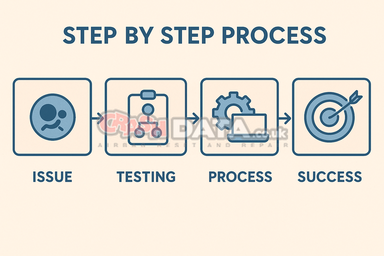The CrashData Guide to Airbag Module Repairs: Keeping Safety Systems in Top Shape
At CrashData, we understand the vital role airbag modules play in your vehicle’s safety system. They don’t just protect you in emergencies, they provide you with peace of mind every time you get behind the wheel. But what happens when these modules develop faults? That’s where we step in. Our expert team is here to diagnose, repair, and, when necessary, advise on replacements. Let’s take a closer look at how we do it and what makes CrashData your go-to partner for airbag module services.
Step 1: Diagnosing the Problem
Our process begins the moment your airbag module arrives at CrashData. We treat every module as a unique case, starting with an in-depth diagnostic assessment. Using state of the art diagnostic tools, we connect the module to our systems to extract fault codes and operational data. Fault codes act as a direct line of communication from the module, revealing underlying issues. For example, one of the most common repairable faults we encounter is “B0100-49” an error inside the control unit itself.
But we don’t just stop at fault codes. We analyze additional data stored in the module, such as operating time, mileage, battery voltage, and even the vehicle’s speed at the time of certain events. This information creates a detailed profile of the module’s health, helping us determine the best course of action. As part of this process, we generate a comprehensive diagnostic report that outlines everything we’ve discovered. This report is invaluable, giving you a clear understanding of the module’s condition and setting the stage for the next step.
Step 2: Can It Be Repaired?
Once we’ve gathered all the necessary data, the next step is to evaluate whether the module can be repaired. At CrashData, we pride ourselves on performing a thorough assessment, leaving no detail unchecked. Unfortunately, some modules are simply beyond repair.
Certain fault codes, like “B0102-00” (indicating grounding issues) or “B0101-16” (pointing to power supply problems), often signal deep-seated electrical or hardware issues that make repair infeasible. Another common obstacle is corrosion on the circuit board. Corrosion not only damages the physical integrity of the module but can also compromise the stored data, making a reset impossible.
In rare cases, a module may fail to communicate entirely with our diagnostic tools. This “silent treatment” is usually a sign of severe internal damage or data corruption, leaving us unable to access the information needed for repairs. When a module is deemed unrepairable, we ensure you’re fully informed and guide you through the next steps.
What Happens When Modules Are Unrepairable?
An unrepairable module doesn’t mean the end of the road, it just means a shift in strategy. At CrashData, we’re here to help you navigate the process of replacing the module with a compatible alternative.
Replacing an airbag module isn’t as simple as swapping one unit for another. The new module must be carefully programmed to match your vehicle’s specific requirements. This process often involves transferring crucial data, such as the vehicle identification number (VIN), mileage, and calibration settings. By ensuring the new module is fully integrated, we help restore your vehicle’s safety systems to their original functionality without the need for main dealer visits.
We know how frustrating it can be to deal with a faulty module, but our team is committed to making the replacement process as smooth and straightforward as possible. Whether it’s sourcing a new module or coordinating programming, we’re with you every step of the way.
Step 3: The Repair Journey
For modules that pass our repair assessment, the journey continues. Once we determine the module is repairable, we begin by using our proprietary in-house software to reset the control unit and remove faults such as the B0100-49 error. This process restores the module’s functionality, ensuring that all associated safety systems are working correctly.
But we don’t just stop there. At CrashData, quality assurance is a top priority. Every repaired module undergoes an extensive testing process to verify its performance. We place the module on our advanced test rig for a minimum of one hour, simulating real-world operating conditions. This allows us to identify any hidden issues that might cause the fault to recur or affect the module’s reliability. Our goal is to ensure that when the module is reinstalled in your vehicle, it operates seamlessly and safely.
Step 4: Transparency Matters
We understand that trust is built on transparency. That’s why, at CrashData, we provide detailed pre- and post-test reports for every module we repair. These reports offer a clear breakdown of what we found during diagnostics, what we fixed during repairs, and how the module performed during testing.
For repaired modules, these reports confirm that the faults have been successfully resolved and that the module is ready to be reinstalled. For unrepairable modules, the report includes a detailed explanation of the issues, helping you make informed decisions about replacement. Whatever the outcome, you’ll never be left in the dark.
Why Choose CrashData?
At CrashData, we’re not just about fixing airbag modules—we’re about restoring confidence. Our team combines technical expertise with a customer-focused approach, ensuring you receive a service that’s not only efficient but also transparent and reliable.
Whether you need a quick repair, a diagnostic evaluation, or advice on replacing a faulty module, CrashData is here to help. Your safety is our priority, and we’re committed to keeping you informed and supported every step of the way.
We hope this guide gives you a deeper understanding of what happens when you trust CrashData.co.uk with your airbag module. If you have questions or need assistance, don’t hesitate to reach out. We’re here to help you get back on the road with peace of mind!

